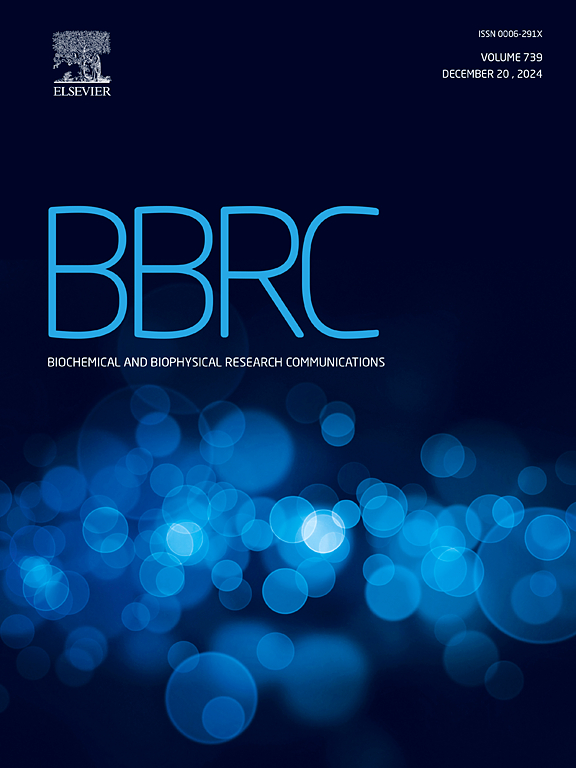PIKFYVE缺乏通过扰乱晚期核内体稳态诱发空泡样白内障。
IF 2.5
3区 生物学
Q3 BIOCHEMISTRY & MOLECULAR BIOLOGY
Biochemical and biophysical research communications
Pub Date : 2025-02-02
DOI:10.1016/j.bbrc.2024.151123
引用次数: 0
摘要
磷酸肌肽激酶(Phosphoinositide kinase, FYVE-type zinc finger containing, PIKFYVE)最近被发现是白内障的致病基因。Pikfyve磷脂酰肌醇磷酸激酶结构域缺陷(pikfyveΔ8)斑马鱼晶体和Pikfyve抑制的人晶体上皮细胞形成液泡,与内核体晚期标记物RAB7共定位。本研究对患有液泡样白内障的pikfyveΔ8zebrafish进行了转录组学和蛋白质组学分析,以探索液泡形成的潜在机制。敲除pikfyve和抑制pikfyve的人晶状体上皮细胞空泡进一步验证了这些组学结果,并用巴菲霉素A1(Baf-A1)和U18666A进行了拯救。我们发现溶酶体融合没有显著差异,但酸水解酶上调。内体晚期膜组成发生改变,空泡atp酶和内体转运所需分选复合物(ESCRT)上调。这些变化与内核体后期稳态有关。引人注目的是,人晶状体上皮细胞中的液泡可以被Baf-A1部分拯救,而被U18666A几乎完全拯救。总之,这些发现表明pikfyveΔ8斑马鱼晶态和pikfyve抑制细胞中的液泡与肿胀的晚期核内体共定位,并且由于ESCRT机制增强和晚期核内体膜稳定性降低而扰乱了晚期核内体的稳态。这项研究扩大了我们对白内障发展机制的理解,并揭示了潜在的有效治疗靶点。本文章由计算机程序翻译,如有差异,请以英文原文为准。
PIKFYVE deficiency induces vacuole-like cataract via perturbing late endosome homeostasis
Phosphoinositide kinase, FYVE-type zinc finger containing (PIKFYVE) was recently identified as a causative gene for cataract. Pikfyve phosphatidylinositol phosphate kinase domain-deficient (pikfyveΔ8) zebrafish lens and PIKFYVE-inhibited human lens epithelial cells developed vacuoles, colocalized with late endosome marker RAB7. In this study, the pikfyveΔ8zebrafish with vacuole-like cataract underwent transcriptomic and proteomic analyses to explore the underlying mechanisms of vacuole formation. PIKFYVE-knockout and PIKFYVE-inhibited human lens epithelial cells with vacuoles further verified these omics results and rescued with Bafilomycin A1(Baf-A1) and U18666A. We discovered no significant differences in lysosomal fusion, but upregulation in acid hydrolase. The composition of late endosomal membrane was changed, and vacuolar ATPase and endosomal sorting complexes required for transport (ESCRT) at late endosome were upregulated. These changes are related with the late endosome homeostasis. Strikingly, vacuoles in human lens epithelial cells could be partially rescued by Baf-A1 and almost completely rescued by U18666A. Collectively, these findings suggest that vacuoles in pikfyveΔ8 zebrafish lens and PIKFYVE-inhibited cells were colocalized with swollen late endosomes, and generated by perturbing late endosome homeostasis due to enhanced ESCRT mechanisms and decreased stability in late endosomal membrane. This study expands our understanding of the mechanisms underlying cataract development and reveals potentially effective therapeutic targets.
求助全文
通过发布文献求助,成功后即可免费获取论文全文。
去求助
来源期刊
CiteScore
6.10
自引率
0.00%
发文量
1400
审稿时长
14 days
期刊介绍:
Biochemical and Biophysical Research Communications is the premier international journal devoted to the very rapid dissemination of timely and significant experimental results in diverse fields of biological research. The development of the "Breakthroughs and Views" section brings the minireview format to the journal, and issues often contain collections of special interest manuscripts. BBRC is published weekly (52 issues/year).Research Areas now include: Biochemistry; biophysics; cell biology; developmental biology; immunology
; molecular biology; neurobiology; plant biology and proteomics

 求助内容:
求助内容: 应助结果提醒方式:
应助结果提醒方式:


